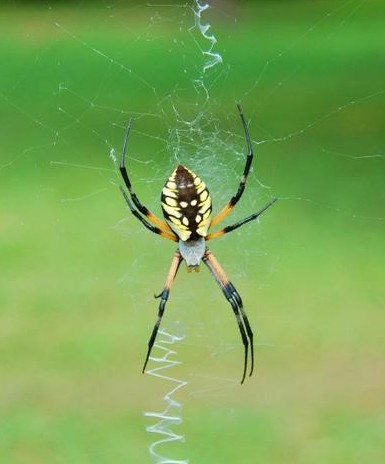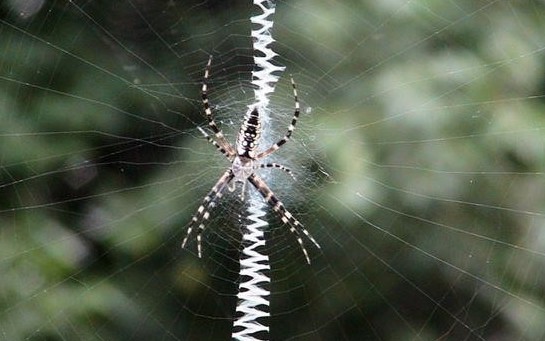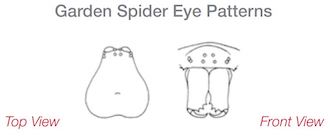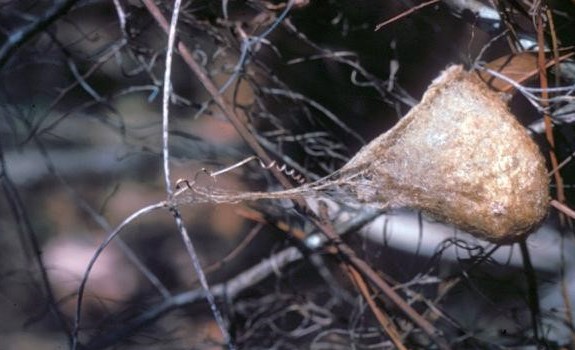Spinning Circular Webs — Black & Yellow Argiope Spiders

Black and yellow Argiope spider in web
by Ann M. Mason, Fairfax Master Gardener
Have you ever observed a spider’s web dangled between the branches of shrubs and called out, “WOW!”? My first experience with the showy, long-legged black and yellow spider jolted me into a state of amazement and curiosity. First, I noticed the striking yellow and black banding on the abdomen. Then, near the center of the web just near a zig zag pattern of thick webbing, I noticed eight exceedingly long, black banded legs spread across the fine webbing. What an astonishing sight!
The object of my exclaim was the docile, garden, black and yellow spider, Argiope aurantia. These are beneficial garden orb-weaver spiders that will eat any insects caught in their sticky threaded web. Named orb-weaver spiders because of their spiral wheel-shaped web, the orbital webs have non sticky radial threads (like the spokes in a wheel) and sticky circular web threads laden with droplets of sticky glycoproteins (sugar proteins). Both female and male spiders construct, or re-construct, the web each night. Noticeable to their web design is the thicker zig zag patterned webbing, called stabilimentum, near the center. Scientists are unsure about the function of the stabilimentum. Some scientists think that it gives the web stability during the spider’s capture method of getting the web to sway (think a swinging motion) when prey land on the webbing. The spider causes this motion by extending the abdomen and legs. The motion further entraps the prey in the sticky web threads that form the spiral. Other scientists think the zig zag pattern alerts birds, so they do not fly into the web and destroy it. Whatever the reason, the construction of the zig zag stabilimentum is a remarkable sight!

Smaller male black and yellow Argiope spider
The black and yellow Argiope spiders rest near the center of their web head facing the ground. They feed during the day or night and hang out on the web rather than hide. They eat a range of insects that fly into the web, some larger than the spiders themselves, including bugs, flies, bees, wasps, stinkbugs, aphids and more. Scientists say that dinner preparation involves injecting venom into the prey to paralyze and kill it and using its legs to wrap prey in silk from the spider’s spinneret, a structure at the tip of the abdomen. They store these wrapped morsels on the web until it’s time to eat.

Eye pattern of the black and yellow Argiope spider
Striking in appearance, the body of the female black and yellow female Argiope spider is about 3/4 to 1-1/8 inches (2 to 3 cm), males are smaller with less coloring. The head and thorax (cephalothorax) of both male and female are mostly white and covered with short, silvery hairs. Of the eight legs, six long, banded legs give the spider a longer, larger appearance, while the other two legs are about half the length of the others. Orb-weaver spiders have three claws on each foot (this is one more that most other spiders). This third claw helps the spiders handle threads when they are spinning their web. Scientists report that their jaws move side to side like scissors. Eight small simple eyes (these do not have multiple lenses) of this spider are widely spaced across the head in paired groupings. Scientists report that these garden spiders do not have good vision but are sensitive to movements on their webs.

Cocoon of the Black and Yellow Argiope Spider
There is one generation per year. Mating occurs in the fall. After mating the male dies and sometimes is consumed by the female as nutrition to produce egg sacs. In early autumn, females lay several to many hundred eggs in each inch long (2.5 cm) brown, papery silk, spherical cocoon. The female attaches cocoons to the web. Females die in the first frost after producing the cocoon.
The black and yellow Argiope spider is a member of the Araneidae family of orb-weaver spiders and are found throughout the continental North America from southern Canada, across the US, Hawaii, Alaska, Mexico and Central America. Thus, these spiders live in many climatic zones. In mild climates, the spiderlings of the black and yellow Argiope spider emerge from the cocoon in the late fall. In cold climates, spiderlings overwinter in the cocoon in a dormant state and emerge in the spring. Unless, of course, hungry birds eat the cocoon, or parasites attack it. Few cocoons survive the winter.
You are fortunate to have this spider in your garden. The black and yellow Argiope spider is your gardening friend, and you can spend time watching its amazing behaviors.
Here is a fun fact. The black and yellow Argiope spider is a ‘cousin’ of the famous, most amazing Charlotte in Charlotte’s Web. She was a barn orb-weaver spider, Araneus cavaticus, also in the family Araneidae.
Since spiders in the family Araneidae can make a stabilimentum, it is not hard to understand the following excerpts from E.B. White’s Charlotte’s Web:
“But we have received a sign, Edith — a mysterious sign. A miracle has happened on this farm . . . in the middle of the web there were the words ‘Some pig’. . . we have no ordinary pig.”
“Well,” said Mrs. Zuckerman, “it seems to me you’re a little off. It seems to me we have no ordinary spider.”
Resources
• Black and Yellow Garden Spider, NC State Extension
• Black and Yellow Garden Spider Spins Her Stabilimentum; Video by Griselle R. Cottinham, youtube
• Garden Spiders Attacking Prey, IloveSPIDERZ, youtube
• Spider Identification Guide, Gerald S. Wegner, BASF, International Pest Management Institute
• Argiope aurantia, George Hammond, Animal Diversity Web, University of Michigan Museum of
Zoology
• Black and Yellow Argiope Spider, Candice Hawkinson, Galveston County Master Gardeners, Texas
A&M University
• Common Spiders of New York , Linda Raynor and Cole Gilbert, Dept. of Entomology,
Cornell University, NY State Department of Environmental Conservation